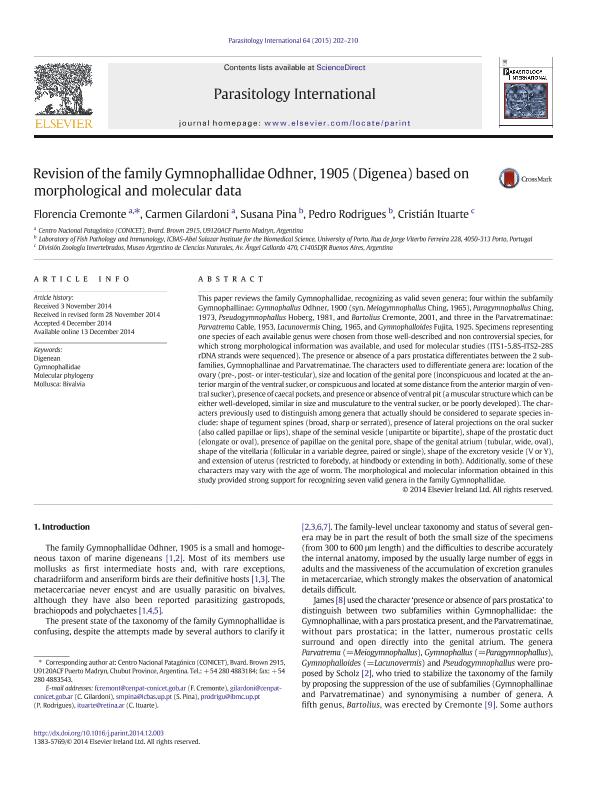Artículo
Revision of the family Gymnophallidae Odhner, 1905 (Digenea) based on morphological and molecular data
Cremonte, Florencia ; Gilardoni, Carmen Mariangel
; Gilardoni, Carmen Mariangel ; Pina, Susana; Rodrigues, Pedro; Ituarte, Cristian Federico
; Pina, Susana; Rodrigues, Pedro; Ituarte, Cristian Federico
 ; Gilardoni, Carmen Mariangel
; Gilardoni, Carmen Mariangel ; Pina, Susana; Rodrigues, Pedro; Ituarte, Cristian Federico
; Pina, Susana; Rodrigues, Pedro; Ituarte, Cristian Federico
Fecha de publicación:
04/2015
Editorial:
Elsevier Ireland
Revista:
Parasitology International
ISSN:
1383-5769
Idioma:
Inglés
Tipo de recurso:
Artículo publicado
Clasificación temática:
Resumen
This paper reviews the family Gymnophallidae, recognizing as valid seven genera; four within the subfamily Gymnophallinae: Gymnophallus Odhner, 1900 (syn. Meiogymnophallus Ching, 1965), Paragymnophallus Ching, 1973, Pseudogymnophallus Hoberg, 1981, and Bartolius Cremonte, 2001, and three in the Parvatrematinae: Parvatrema Cable, 1953, Lacunovermis Ching, 1965, and Gymnophalloides Fujita, 1925. Specimens representing one species of each available genus were chosen from those well-described and non controversial species, for which strong morphological information was available, and used for molecular studies (ITS1-5.8S-ITS2-28S rDNA strands were sequenced). The presence or absence of a pars prostatica differentiates between the 2 subfamilies, Gymnophallinae and Parvatrematinae. The characters used to differentiate genera are: location of the ovary (pre-, post- or inter-testicular), size and location of the genital pore (inconspicuous and located at the anterior margin of the ventral sucker, or conspicuous and located at some distance from the anterior margin of ventral sucker), presence of caecal pockets, and presence or absence of ventral pit (a muscular structure which can be either well-developed, similar in size and musculature to the ventral sucker, or be poorly developed). The characters previously used to distinguish among genera that actually should be considered to separate species include: shape of tegument spines (broad, sharp or serrated), presence of lateral projections on the oral sucker (also called papillae or lips), shape of the seminal vesicle (unipartite or bipartite), shape of the prostatic duct (elongate or oval), presence of papillae on the genital pore, shape of the genital atrium (tubular, wide, oval), shape of the vitellaria (follicular in a variable degree, paired or single), shape of the excretory vesicle (V or Y), and extension of uterus (restricted to forebody, at hindbody or extending in both). Additionally, some of these characters may vary with the age of worm. The morphological and molecular information obtained in this study provided strong support for recognizing seven valid genera in the family Gymnophallidae.
Palabras clave:
Digenean
,
Gymnophallidae
,
Molecular Phylogeny
,
Mollusca Bivalvia
Archivos asociados
Licencia
Identificadores
Colecciones
Articulos(CCT-CENPAT)
Articulos de CTRO.CIENTIFICO TECNOL.CONICET - CENPAT
Articulos de CTRO.CIENTIFICO TECNOL.CONICET - CENPAT
Articulos(MACNBR)
Articulos de MUSEO ARG.DE CS.NAT "BERNARDINO RIVADAVIA"
Articulos de MUSEO ARG.DE CS.NAT "BERNARDINO RIVADAVIA"
Citación
Cremonte, Florencia; Gilardoni, Carmen Mariangel; Pina, Susana; Rodrigues, Pedro; Ituarte, Cristian Federico; Revision of the family Gymnophallidae Odhner, 1905 (Digenea) based on morphological and molecular data; Elsevier Ireland; Parasitology International; 64; 2; 4-2015; 202-210
Compartir
Altmétricas



